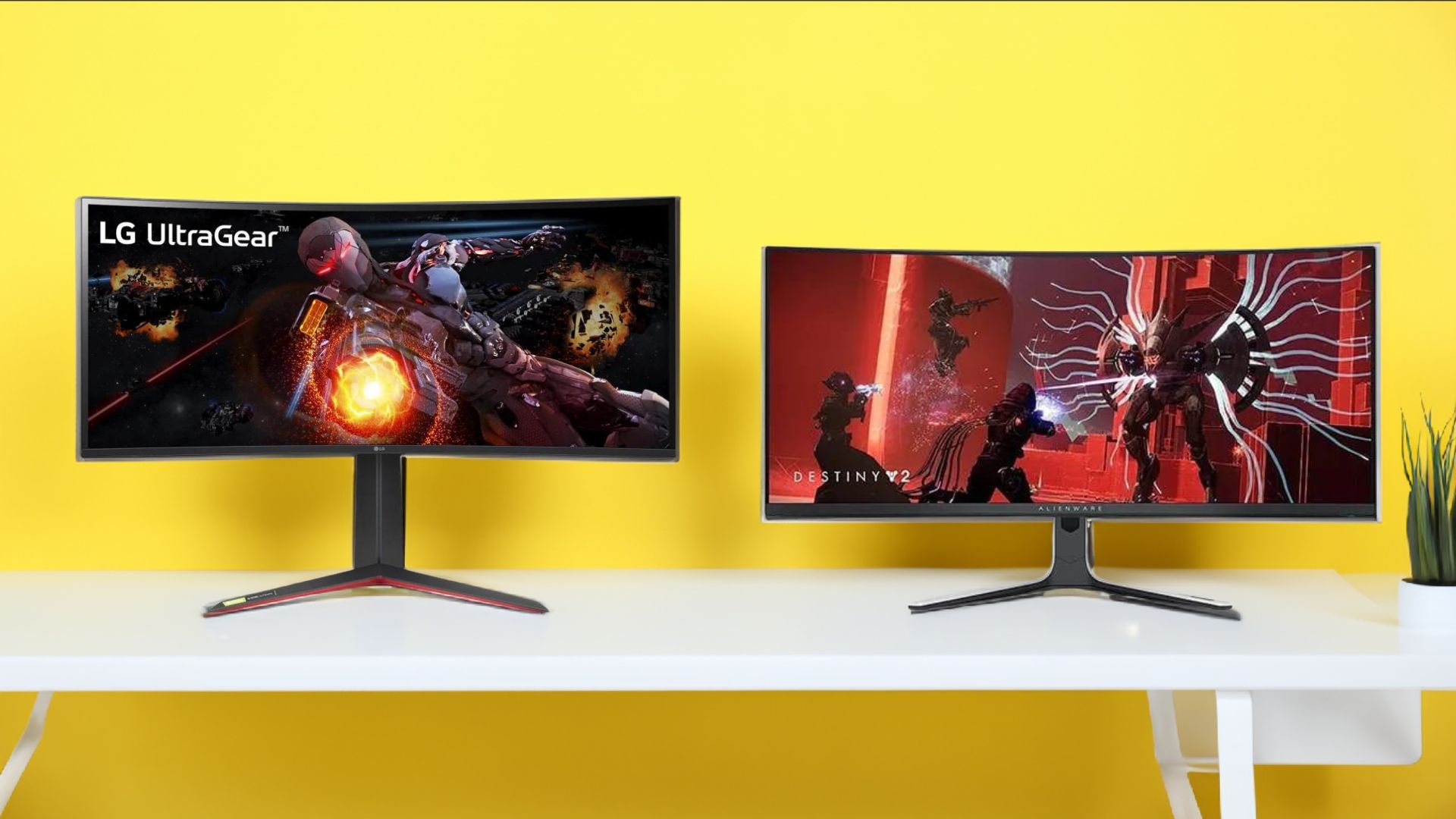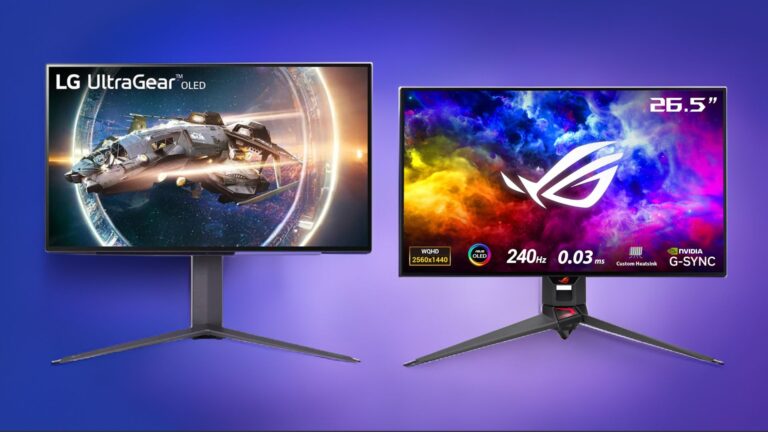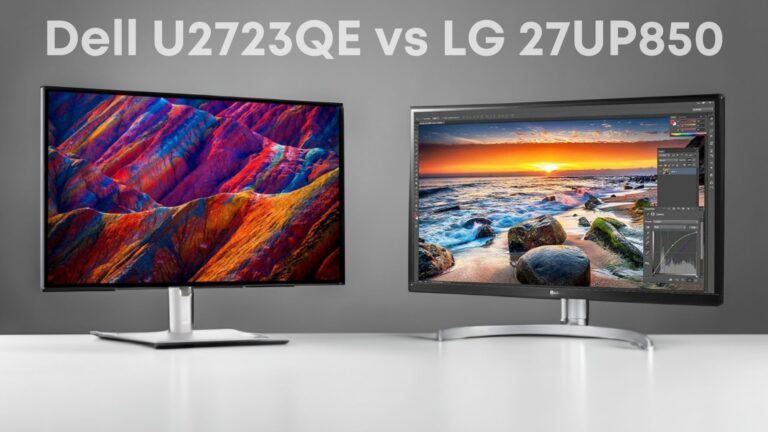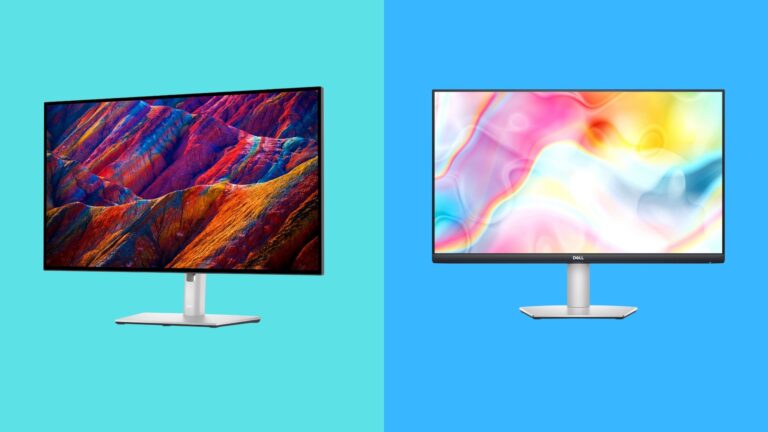So, we have two 34-inch widescreen gaming monitors that have attracted attention with their performance and immersive visuals. One of them is the LG 34GP950G-B, and the other is the Alienware AW3423DW. In this article, we have compared all the features, performance, specs, and everything side by side of both these monitors so that you can choose the best monitor for your gaming needs.
 |  | |
|---|---|---|
| Check Price | Check Price | |
| Key Specs | Alienware AW3423DWF | LG 34GP950G-B |
| Refresh Rate | 165Hz | 144Hz |
| Maximum Resolution | 3440 x 1440 | 3440 x 1440 |
| Native Resolution | 3440 x 1440 | 3440 x 1440 |
| Response Time | 0.1 milliseconds | 1 millisecond |
| Panel Type | QD-OLED | IPS |
| Synchronization Technology | FreeSync Premium Pro (AMD Adaptive Sync) | G-SYNC Ultimate (NVIDIA Adaptive Sync) |
| Screen Size | 34 inches | 34 inches |
| Connectivity | Alienware AW3423DWF | LG 34GP950G-B |
| Number of HDMI Inputs | 1 | 1 |
| Display Connector(s) | 2 x DisplayPort 1.4, 1 x HDMI 2.0 | 1 x HDMI |
| Number of USB Ports | 5 | 3 |
| Display | Alienware AW3423DWF | LG 34GP950G-B |
| Contrast Ratio | 1,000,000:1 | 700:1 (min), 1000:1 (typ) |
| Brightness | 1000 candela per square meter | 400 candela per square meter |
| High Dynamic Range (HDR) | Yes | Yes |
| High Dynamic Range Format | VESA Certified DisplayHDR 400 True Black | VESA Certified DisplayHDR 600 |
| General | Alienware AW3423DWF | LG 34GP950G-B |
| Brand | Alienware | LG |
| Model Number | AW3423DWF | 34GP950G-B.AUS |
| Color | Dark Side of the Moon (Black) | Black |
| Features | Alienware AW3423DWF | LG 34GP950G-B |
| Tiltable | Yes | Yes |
| Adjustable Stand Height | Yes | Yes |
| Eye Relief Features | Low blue light | Flicker free, Environment brightness sensor, Anti-glare |
| Dimensions | Alienware AW3423DWF | LG 34GP950G-B |
| Product Height With Stand | 20.69 inches | 22.8 inches |
| Product Width | 32.1 inches | 32.1 inches |
| Product Weight | 21.27 pounds | 20.1 pounds |
Price & Display Resolution
Among the two, the LG 34GP950-B is the cheaper option, currently priced around $950, while the Alienware AW3423DW is available at a price of $1080. Both monitors prove to be worth the money spent, given their features and performance.
Both monitors offer an ultrawide 3440x1440p, also known as UWQHD resolution, and both have the same pixel density of 109 ppi. Due to their widescreen, they have a maximum aspect ratio of 21:9. Both display quite sharp and crisp images. However, the 34GP950G-B offers better text clarity compared to the AW3423DW. This is because the 34GP950G-B uses a Standard RGB layout, while the AW3423DW has a triangular subpixel layout, making it slightly more noticeable when viewed up close.
Panel & Refresh Rate
The LG 34GP950G-B features a nano IPS panel, which offers vibrant colors along with a very fast response time compared to a typical IPS panel.
But the Alienware AW3423DW takes a slight lead in terms of the panel, because it utilizes a QD-OLED technology panel, which is a highlight of this monitor. This is a groundbreaking display that is pushing the boundaries of visual excellence in gaming and multimedia.
To reduce reflections, the 34GP950G-B screen has an anti-glare matte coating, while the AW3423DW screen has an anti-reflective glossy coating. This is better for gaming as it doesn’t show the fuzziness seen in matte coatings, making it crisper than monitors with matte coatings.
The 34GP950G-B offers a response time of 1 ms, while the AW3423DW provides a slightly better 0.5 ms response time. However, when it comes to input lag, the 34GP950G-B is more rapidly responsive. Both monitors exhibit virtually no motion blur and ghosting when playing fast-action games.
The AW3423DW features a display boasting a 165 Hz refresh rate, while the 34GP950G-B houses a screen with a base refresh rate of 144Hz, which can be overclocked to reach up to 180 Hz. Both monitors deliver exceptional gaming performance with the G-sync Ultimate technology. Enabling it results in a very noticeable difference in games, especially in fast-paced ones.

Brightness, Colors & Contrast Ratio
Both of these monitors are good and quite bright. Speaking first about their SDR brightness, in my testing, the 34GP950G-B had a brightness of 450 NITS, while the AW3423DW offers a brightness of 600 NITS.
In terms of HDR brightness, the AW3423DW shows a significant jump. This is because it has an HDR 1000 rating, which allows it to achieve a peak brightness of 1000 NITS. However, this level of brightness is not uniformly present across the entire screen; it’s only found in smaller areas of the screen. Additionally, there’s a phenomenon of brightness shifting in its HDR mode, although this might not be noticeable during gaming.
But the 34GP950G-B also features an HDR 600 rating, and it delivers excellent HDR performance as well. During my testing, it even surpassed the 600 NITS rating and reached up to 650 NITS.
With this level of brightness, both monitors can be comfortably used in well-lit rooms without any issues. However, I would suggest that for the AW3423DW, to achieve the best picture quality, you use it in a dark room. That’s where you’ll truly experience the potential of OLED’s capabilities.
In the AW3423DW monitor, you also get the option of DisplayHDR 400 True Black, which provides a greater dynamic range and better deeper blacks. And in the 34GP950G-B monitor, to improve black levels, there is a Local Dimming feature with 56 zones. While this might not be incredibly extensive, it does make a noticeable difference, especially in dark games. This feature takes those black shades that are normally displayed as gray and enhances them. However, it might not achieve the same depth of black levels as the AW3423DW.
Speaking about color gamut, both of these displays feature vibrant and wide color coverage due to the use of IPS and QD technology. In my testing, I found that the 34GP950G-B exhibited 99% of sRGB, 89% of Adobe RGB, and 98% of DCI-P3 color gamut coverage. Similarly, the AW3423DW also showcased nearly similar coverage with 100.0% of sRGB, 94.8% of Adobe RGB, and 99.4% of DCI-P3.
Furthermore, both of these monitors offer nearly perfect pre-calibration, allowing for tasks like photo and video editing to be performed accurately.
Both monitors are capable of displaying 1.07 billion colors, but the 34GP950G-B utilizes FRC and 8-bit color depth, which means it’s not truly a 10-bit display. On the other hand, the AW3423DW offers an actual 10-bit color depth. However, the issue here is that both monitors only support 8-bit color depth when operating at their high refresh rates. If you want to utilize their 10-bit color capability, you need to lower the refresh rate to 144 Hz or lower.
If we shift our focus towards contrast, the 34GP950G-B falls significantly behind compared to the AW3423DW. This is because the AW3423DW features a QD-OLED panel, resulting in a contrast ratio of 1000000:1. On the other hand, the 34GP950G-B, with its IPS panel, offers a standard contrast ratio of 1000:1.
AW3423DW features an OLED panel, you might be concerned about the potential for burn-in and image retention issues. However, to address this concern, Alienware provides OLED Panel maintenance options in this monitor. These options include features like pixel refresh and panel refresh.
Pixel refresh is designed to counter temporary image retention and takes around 7 to 8 minutes to complete, during which the monitor remains off. A warning message prompts you to perform this every four hours.
On the other hand, panel refresh addresses permanent image retention and takes a full 60 minutes to complete. The warning message for this process appears only after prolonged usage.
Having that popup automatically appear every four hours is a bit annoying, especially while gaming. So, if you want, you can go to the OSD settings and use it manually instead of automatically. But I would suggest that if it’s not too important, you should leave this feature on automatic. That would be better for extending the display’s lifespan.
Features & Menu
The 34GP950G-B features a user-friendly menu system, which is controlled through a joystick located at the bottom front middle chin of the monitor. This joystick is colored in a vibrant red, making it easy to spot, and its responsive nature allows for quick navigation.
There are two applications available for controlling its settings without directly accessing the menu system. The first is LG On-Screen Control, while the second is the UltraGear Control Center.
LG On-Screen Control offers a limited set of options, including brightness, contrast, black stabilizer, response time, picture-in-picture, and picture-by-picture. On the other hand, the UltraGear Control Center provides the ability to adjust settings related to the RGB ring located at the back of the monitor.
But in comparison to the 34GP950G-B, I didn’t quite like the menu system of the AW3423DW, because its User Interface wasn’t that good. However, if we set the UI aside, it works quite well.
To control the menu system of the AW3423DW, you’ll find a small black joystick located under the bottom chin, just like in the 34GP950G-B. This joystick is also fast and easy to access.

Design & Build
In the design of the 34GP950G-B, I don’t see many changes. It looks quite similar to LG’s previous UltraGear monitors, with three-sided thin bezels and the same black and red tone. However, the RGB ring around the rear side stand attachment is better than its previous model. This ring also helps maintain airflow.
If you’re looking for a monitor that looks very premium, then the AW3423DW fulfills that search. This monitor is a fantastic mix of matte white and black look, with an ellipse-shaped RGB light on the rear side, creating a striking aesthetic. Additionally, its three-sided borderless design makes its display view look very impressive.
The AW3423DW also has a built-in cooling fan for heat management. Its noise isn’t very noticeable, but in a silent environment, its annoying sound can be heard. The biggest issue is that there’s no option to turn it off.
Both have good build quality. Their bodies are made of plastic, which feels quite solid and of good quality. However, the build of the AW3423DW seems slightly better than the 34GP950G-B. The display curvature in the 34GP950G-B is slightly more at 1900R, while in the AW3423DW, it’s 1800R. Both offer comfortable viewing angles.
The stand of the AW3423DW is somewhat bulky, and the 34GP950G-B also has a similar thick stand. But the AW3423DW’s stand is slightly raised from the back, meaning it doesn’t touch the ground. Hence, when making ergonomic adjustments, it wobbles a bit. In contrast, the 34GP950G-B’s stand doesn’t wobble at all.
Both offer decent ergonomic adjustments. For instance, the 34GP950G-B has a 12 cm height, 5° forward tilt, and -20° backward tilt adjustments. The AW3423DW offers almost the same with 11 cm height and 5°/-21° tilt adjustments. Neither offers swivel and portrait adjustments.
Both the AW3423DW and 34GP950G-B monitor stands have thin but wide footprints, providing good stability. However, due to their wide legs and thick stands, both monitors require a spacious deep desk. Both come with VESA compatibility, so if you want, you can use another monitor arm instead of their stands.
Ports
The 34GP950G-B has a simple arrangement. All the ports are located on the right side at the back where the stand attaches. It includes 1x HDMI 2.0 port, 1x DisplayPort 1.4, 1x USB Type-B upstream, 2x USB Type-A downstream ports, and 1x 3.5 mm audio output ports. If you frequently connect different devices and plug cables in and out, this placement will be more convenient for you.
However, the AW3423DW offers more ports than the 34GP950G-B. On the back, at the bottom, it has 2X HDMI 2.0 ports, 1X DisplayPort 1.4, 1X USB Type-B Upstream port, 2X USB Type-A downstream ports, and 1X 3.5 mm audio output. Additionally, on the front chin of the monitor, there are also 2X USB Type-A ports and 1X 3.5 mm audio output port. This makes it easy to connect peripherals like phones, charge laptops, and plug in headphones.
However, both lack HDMI 2.1, causing them to be stuck at a 100 Hz refresh rate when using an HDMI connection. Neither of them offers a USB-C port for laptops and Macs, which is a bit disappointing.
Which is Better for You?
Overall, my experience with the AW3423DW monitor was very good. It’s not a completely perfect monitor, but it does come close to perfection with its colors, exceptional performance, and range of features. It’s one of the best 1440p monitor options in the market for gamers and multimedia enthusiasts, and it’s worth spending your hard-earned money on.
On the other hand, the 34GP950G-B is also a strong contender. For almost $100 less than the AW3423DW, it offers a higher refresh rate, better text clarity, improved SDR brightness, and superior input lag.
Now, the decision is up to you. If you want a monitor solely for gaming, then the 34GP950G-B is a good option. But if you want to use your monitor for both work and play setups, then the AW3423DW is the best choice.






